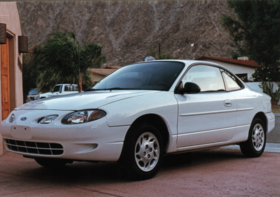
The Ford Fiesta is a supermini marketed by Ford since 1976 over seven generations. It has been manufactured in the United Kingdom, Germany, Spain, Australia, Brazil, Argentina, Venezuela, Mexico, China, India, Thailand, and South Africa.

The Ford Probe is a liftback coupé produced by Ford, introduced in 1988 and produced until 1997. The Probe was the result of Ford's collaboration with its longtime Japanese partner, Mazda, and both generations of Probe were derived from the front-wheel drive Mazda G platform that underpinned the Mazda Capella.

The CVH engine was introduced by Ford in 1980 in the third generation European Ford Escort and for the 1981 North American Escort. It was later used in the Ford Sierra as well as the second generation Ford Fiesta and from 1983 it was used in the Ford Orion. Engines were built in the Dearborn Engine Plant for the North American market, and in Ford's then-new engine plant in Bridgend in Wales for the European market.
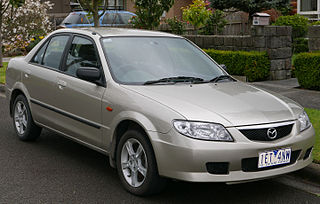
The Mazda Familia, also marketed prominently as the Mazda 323 and Mazda Protegé, is a small family car that was manufactured by Mazda between 1963 and 2003. The Familia line was replaced by the Mazda3/Axela for 2004.
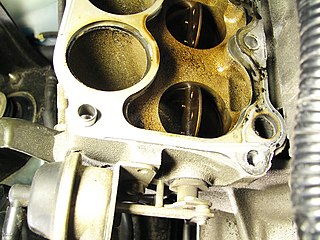
In internal combustion engines, a variable-length intake manifold (VLIM),variable intake manifold (VIM), or variable intake system (VIS) is an automobile internal combustion engine manifold technology. As the name implies, VLIM/VIM/VIS can vary the length of the intake tract - in order to optimise power and torque across the range of engine speed operation, as well as help provide better fuel efficiency. This effect is often achieved by having two separate intake ports, each controlled by a valve, that open two different manifolds - one with a short path that operates at full engine load, and another with a significantly longer path that operates at lower load. The first patent issued for a variable length intake manifold was published in 1958, US Patent US2835235 by Daimler Benz AG.
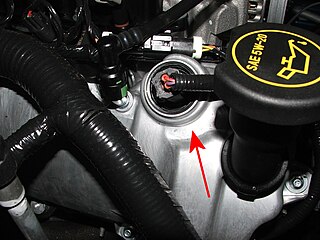
Variable Camshaft Timing (VCT) is an automobile variable valve timing technology developed by Ford. It allows for more optimum engine performance, reduced emissions, and increased fuel efficiency compared to engines with fixed camshafts. It uses electronically controlled hydraulic valves that direct high pressure engine oil into the camshaft phaser cavity. These oil control solenoids are bolted into the cylinder heads towards the front of the engine near the camshaft phasers. The powertrain control module (PCM) transmits a signal to the solenoids to move a valve spool that regulates the flow of oil to the phaser cavity. The phaser cavity changes the valve timing by rotating the camshaft slightly from its initial orientation, which results in the camshaft timing being advanced or retarded. The PCM adjusts the camshaft timing depending on factors such as engine load and RPM.

The Nissan 350Z is a two-door, two-seater sports car that was manufactured by Nissan Motors from 2002 to 2009 and marks the fifth generation of Nissan's Z-car line. The 350Z entered production in late 2002 and was sold and marketed as a 2003 model. The first year there was only a coupe, as the roadster did not debut until the following year. Initially, the coupe came in Base, Enthusiast, Performance, Touring and Track versions, while the Roadster was limited to Enthusiast and Touring trim levels. The Track trim came with lightweight wheels and Brembo brakes, but its suspension tuning was the same as all other coupes. The Nissan 350Z has been succeeded by the 370Z since the 2009 model year.
The Mazda B-series engine - not to be confused with the Mazda B-Series truck - is a small-sized, iron-block, inline four-cylinder with belt-driven SOHC and DOHC valvetrain ranging in displacement from 1.1 to 1.8 litres. It was used from front-wheel drive economy applications to the turbocharged full-time 4WD 323 GTX and rear-wheel drive Miata as well as numerous other models. The Mazda B-series is a "non-interference" design, meaning that breakage of its timing belt does not result in damage to valves or pistons, because the opening of the valves, the depth of the combustion chamber and the shaping of the piston crown allow sufficient clearance for the open valves in any possible piston position.
The Mazda B platform is an automobile platform for compact cars. It has been used by a number of vehicles from Mazda and Ford Motor Company in Japan and abroad.
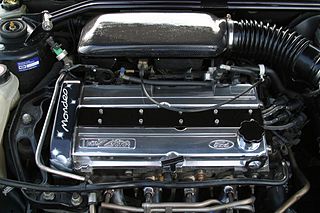
Developed in the late 1980s by the Ford Motor Company, the Ford Zetec engine was a straight-4, double overhead cam internal combustion engine with which Ford had intended to replace the analogous Pinto and CVH models.

The Ford Escort is a small family car which was manufactured by Ford Europe from 1968 to 2004. The Ford Escort name was also applied to several different small cars produced in North America by Ford between 1981 and 2004.
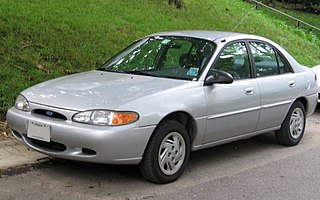
The North American variant of the Ford Escort is a small family/compact car introduced by Ford in 1980 for the 1981 model year. Adopting the "Escort" name used by Ford of Europe since 1968 along with the general design and layout of the third-generation European Escort, it was the successor of the Ford Pinto, which had a tarnished reputation for quality and safety after a widely publicized fuel tank defect. The Escort was one of Ford's most successful models in the 1980s, earning a much better reputation than the Pinto. The Escort was the single best-selling car in its second year in the United States and during most of that decade.
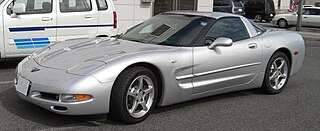
The Chevrolet Corvette (C5) is the fifth generation of the Chevrolet Corvette sports car, produced by the Chevrolet division of General Motors for the 1997 through 2004 model years. Production variants include the high performance Z06. Racing variants include the C5-R, a 24 Hours of Daytona and 24 Hours of Le Mans GTS/GT1 class winner.

The Mazda Kabura is a concept car shown by the Japanese manufacturer Mazda in 2006.

The fourth generation of the Camaro was produced by American automobile manufacturer Chevrolet for the 1993 through 2002 model years; although the last 30 models were unofficially sold in 2003. It was introduced on an updated F-body platform, but would retain the same characteristic since the first-generation's introduction back in 1967; 2-doors, 2+2 seating, coupe or convertible bodystyles, rear-wheel drive, and a choice of pushrod V6 and V8 powerplants. The Camaro was refreshed and revised in 1998 with both exterior and engine changes. The fourth-generation of the Camaro would continue production up to the 2002 model year when General Motors discontinued production due to slow sales, a deteriorated sports coupé market, and plant overcapacity.
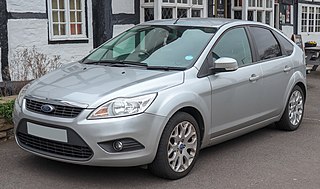
The Ford Focus Mk 2 is an automobile which was produced by Ford from 2005 to 2010. It was launched at the Paris Motor Show on September 23, 2004 as a three and five-door hatchback and an estate, although the new car was previewed, in 4-door saloon form, as the 'Focus Concept' developed by Ford Europe at the Beijing Motor Show in mid-2005.

The Ford Focus is a compact car that was manufactured by Ford in Europe from 1998-2004 and by Ford in North America from 1999-2007. Ford began sales of the Focus to Europe in July 1998 and in North America during 1999 for the 2000 model year. Manufacturing in Argentina continued until 2008, and it was still on sale in Brazil until 2009.

Ford Motor Company used the Zetec name on a variety of inline 4-cylinder automobile engines. It was coined to replace "Zeta" on a range of 1.6 L to 2.0 L multi-valve engines introduced in 1991 because Ford was threatened with legal action by Lancia who owned the Zeta trademark. The company used the name widely in European advertising and later introduced it to the North American market with the Contour.

The Ford Mondeo I is a mid-size car that was produced by Ford, beginning on 23 November 1992, with sales beginning on 22 March 1993. It is also known as the Mk I Mondeo; the 1996 facelift versions are usually designated Mk II. Available as a four-door saloon, a five-door hatchback, and a five-door estate, all models for the European market were produced at Ford's plant in the Belgian city of Genk. In December 1992, Autocar published a section on the Mondeo, and how it would conquer rivals.
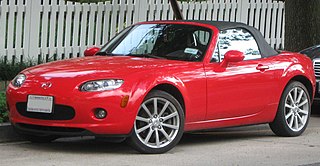
The Mazda MX-5 (NC) is the third generation of the Mazda MX-5 manufactured from 2005 to 2015. At its introduction in 2005, it won the Car of the Year Japan Award and made Car and Driver's 10Best list from 2006 to 2013. The NC is the first MX-5 generation to feature a retractable hardtop variant, with its roof being able to fold and unfold in 12 seconds without sacrificing trunk space.
